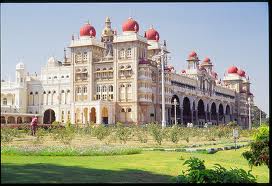| National Things | |
| National Flag |  The
National Flag is the horizontal tricolor of deep saffron (kesaria) at
the top, white in the middle, and dark green at the bottom in equal
proportion. At the center of the white band is a navy blue wheel, which
is a representation of the Ashoka Chakra at Sarnath. The
National Flag is the horizontal tricolor of deep saffron (kesaria) at
the top, white in the middle, and dark green at the bottom in equal
proportion. At the center of the white band is a navy blue wheel, which
is a representation of the Ashoka Chakra at Sarnath. |
| National Emblem |  The
National Emblem of India is derived from the time of the Emperor
Ashoka. The emblem is a replica of the Lion of Sarnath, near Varanasi in
Uttar Pradesh. The Lion Capital was erected in the third century BC by
Emperor Ashoka to mark the spot where Buddha first proclaimed his gospel
of peace and emancipation to the four quarters of the universe. The
National Emblem of India is derived from the time of the Emperor
Ashoka. The emblem is a replica of the Lion of Sarnath, near Varanasi in
Uttar Pradesh. The Lion Capital was erected in the third century BC by
Emperor Ashoka to mark the spot where Buddha first proclaimed his gospel
of peace and emancipation to the four quarters of the universe. |
| National Anthem |  The
Jana Gana Mana is the national Anthem of India, composed by
Rabindranath Tagore. It was officially adopted by the constituent
Aseembly as the Indian national anthem on January 24, 1950. The
Jana Gana Mana is the national Anthem of India, composed by
Rabindranath Tagore. It was officially adopted by the constituent
Aseembly as the Indian national anthem on January 24, 1950. |
| National Song |  Bankim Chandra Chatterji's composed song "Vande Mataram" was adopted as the National Song. It has an equal status with "Jana Gana Mana". It was first sung in the 1896 session of the Indian National Congress. Bankim Chandra Chatterji's composed song "Vande Mataram" was adopted as the National Song. It has an equal status with "Jana Gana Mana". It was first sung in the 1896 session of the Indian National Congress. |
| National Animal |  Tiger is the National Animal of India. It is symbol of India's wildlife
wealth. The magnificent tiger, Panthera tigris, is a striped animal.
Tiger is the National Animal of India. It is symbol of India's wildlife
wealth. The magnificent tiger, Panthera tigris, is a striped animal. |
| National Bird |  The Peacock, Pavo cristatus, is the national bird of India. Emblematic of qualities such as beauty grace, pride. The Peacock, Pavo cristatus, is the national bird of India. Emblematic of qualities such as beauty grace, pride. |
| National Fruit |  Mango is the national fruit of India. Described as the "Food of the
Gods", in the sacred Vedas, the fruit is grown almost in all parts of
India.
Mango is the national fruit of India. Described as the "Food of the
Gods", in the sacred Vedas, the fruit is grown almost in all parts of
India. |
| National Flower |  Lotus botanically known as the Nelumbo Nucifera is the national flower of India. Lotus botanically known as the Nelumbo Nucifera is the national flower of India. |
| National Tree |  Banyan
Tree is the National Tree of India. This huge tree towers over its
neighbours and has the widest reaching roots of all known trees. Banyan
Tree is the National Tree of India. This huge tree towers over its
neighbours and has the widest reaching roots of all known trees. |
| National Calender |  The Saka calender is the national calender of India. It is used, alongside the Gregorian calender. The Saka calender is the national calender of India. It is used, alongside the Gregorian calender. |
| National Days. | 26th January (Republic Day) 15th August (Independence Day) 2nd October (Gandhi Jayanti; Mahatma Gandhi’s Birthday) |
| Government | |
| Country Name | Republic of India; Bharat Ganrajya |
| Government Type | Sovereign Socialist Democratic Republic with a Parliamentary system of Government |
| Capital | New Delhi |
| Official Language | Hindi, English |
| Administrative Division | 28 States and 7 Union Territories. |
| Independence | 15th August 1947 (From the British Colonial Rule) |
| Constitution | The Constitution of India came into force on 26th January 1950. |
| Legislature | Sansad |
| Legal System | The Constitution of India is the fountain source of the legal system in the Country. |
| Executive Branch | The President of India is the Head of the State, while Prime Minister is the Head of the Government, and runs office with the support of Council of Ministers who form the Cabinet Ministry. |
| Legislative Branch | The Indian Legislature comprises of the Lok Sabha (House of the people) and the Rajya Sabha (Council of States) forming both the Houses of the Parliament. |
| Judicial Branch | The Supreme Court of India is the apex body of the Indian legal system, followed by other High Courts and subordinate Courts. |
 |
| FAMOUS IN INDIA |


